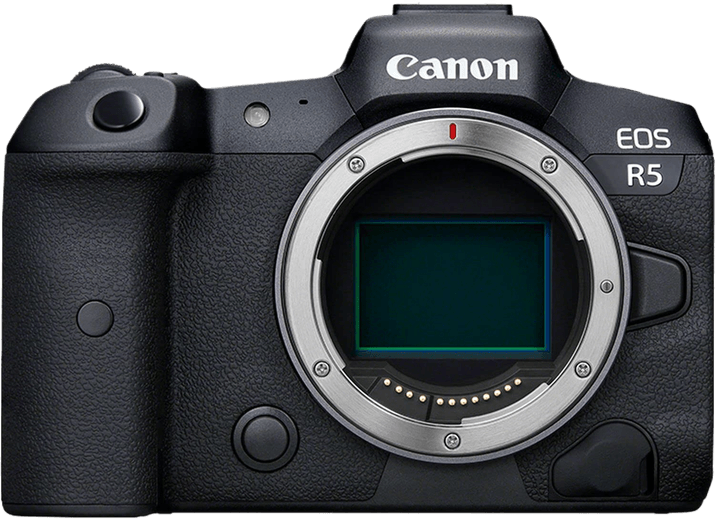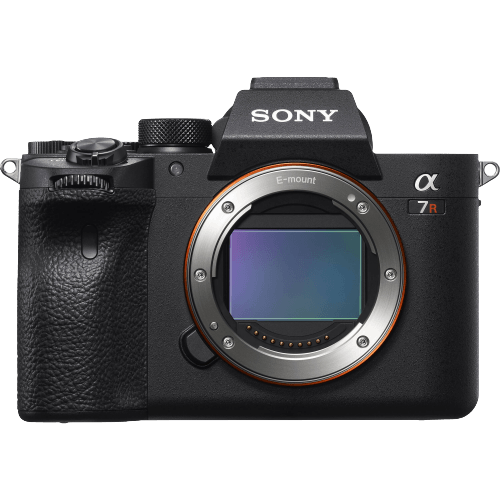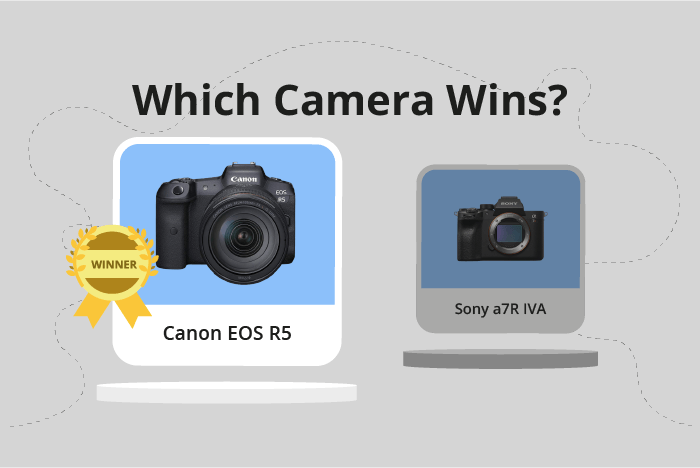Canon EOS R5 vs Sony a7R IVA Comparison
Canon EOS R5

Sony a7R IVA

The Canon EOS R5 narrowly edges out the Sony a7R IVA with a score of 86/100 compared to 85/100. Both cameras are mirrorless models released in 2020 and 2021, respectively. They share similarities in size and weight, with the Canon measuring 138 x 98 x 88mm and weighing 680g, while the Sony is slightly smaller and lighter at 129 x 96 x 78mm and 665g.
The Canon EOS R5’s higher score is due to its superior performance in certain aspects. However, the Sony a7R IVA has its advantages, such as a lower launch price of $3500 compared to the Canon’s $4499. This makes the Sony a more budget-friendly option for those looking for a high-quality mirrorless camera.
Taking all factors into account, the Canon EOS R5 is a better camera overall, but the Sony a7R IVA remains a viable choice for those seeking a more affordable option.
Canon EOS R5 vs Sony a7R IVA Overview and Optics
The Canon EOS R5 outperforms the Sony a7R IVA in optics with a score of 88/100 compared to Sony’s 85/100. Both cameras share several specifications, such as a CMOS sensor, full-frame sensor size, and image stabilization. They also have lens mounts specific to their respective brands: Canon RF for the EOS R5 and Sony FE for the a7R IVA.
The Canon EOS R5 excels with its shooting speed of 20 frames per second, making it ideal for capturing fast-moving subjects. Additionally, its Digic X processor contributes to the camera’s overall performance, enabling faster image processing and better noise reduction. Although the EOS R5 has a lower DXOMARK sensor score (95) compared to the Sony a7R IVA (99), its superior shooting speed and processor make it a better choice for photographers prioritizing speed and performance.
On the other hand, the Sony a7R IVA has a higher megapixel count of 61, allowing for more detailed images compared to the Canon EOS R5’s 45 megapixels. This advantage is beneficial for photographers who focus on landscapes, architecture, or other subjects where higher resolution is crucial. The a7R IVA also has a higher DXOMARK sensor score (99), indicating better overall image quality.
Despite the higher megapixel count and DXOMARK sensor score of the Sony a7R IVA, the Canon EOS R5’s faster shooting speed and powerful processor give it an edge in the optics comparison. However, photographers who prioritize image resolution and quality should consider the Sony a7R IVA for its superior megapixel count and DXOMARK sensor score. Ultimately, the choice between these two cameras depends on the specific needs and preferences of the photographer.
Canon EOS R5 vs Sony a7R IVA Video Performance
The Canon EOS R5 outperforms the Sony a7R IVA in video capabilities, with a score of 100/100 compared to Sony’s 91/100. Both cameras share some common specifications, including a maximum video frame rate of 120fps and built-in time-lapse functionality.
The Canon EOS R5 surpasses the Sony a7R IVA in video resolution and dimensions. The R5 offers an impressive 8K maximum video resolution, with dimensions of 8192 x 4320, while the a7R IVA only provides 4K resolution and dimensions of 3840 x 2160. This significant difference in resolution and dimensions means that the EOS R5 captures videos with higher quality and detail compared to the a7R IVA.
However, the Sony a7R IVA is not without its strengths. With a video score of 91/100, it still delivers excellent video performance. The 4K resolution and 120fps frame rate are sufficient for most professional and amateur videographers. Moreover, the built-in time-lapse functionality adds versatility to the camera’s video capabilities.
Comparing the two cameras, the Canon EOS R5 stands out as the superior choice for videographers seeking the highest possible video quality and resolution. The 8K video capabilities provide a significant advantage over the Sony a7R IVA’s 4K resolution. Meanwhile, the Sony a7R IVA remains a solid option for those who prioritize other features and are satisfied with 4K video performance.
Canon EOS R5 vs Sony a7R IVA Features and Benefits
The Canon EOS R5 wins the features comparison with a score of 87/100, while the Sony a7R IVA scores 85/100. Both cameras share several specifications, including touchscreen capabilities, flip screens, and the absence of GPS. They also both have WIFI and Bluetooth connectivity.
The Canon EOS R5 has a larger screen size of 3.2 inches compared to the Sony a7R IVA’s 3-inch screen. This larger screen provides a better viewing experience for users when composing shots or reviewing images. Furthermore, the EOS R5’s screen resolution is 2,100,000 dots, slightly lower than the a7R IVA’s 2,360,000 dots. Despite the lower resolution, the R5’s larger screen size still offers a more enjoyable user experience.
On the other hand, the Sony a7R IVA’s higher screen resolution may provide crisper and clearer image previews. This can be beneficial for photographers who need to scrutinize image details closely. However, the difference in resolution is not significant enough to outweigh the advantages of the R5’s larger screen.
Considering the features of both cameras, the Canon EOS R5 holds a slight edge over the Sony a7R IVA due to its larger screen size. This advantage contributes to the R5’s higher feature score. The Sony a7R IVA, while having a higher screen resolution, does not offer enough benefits to surpass the R5 in this comparison. Thus, the Canon EOS R5 is the better camera in terms of features.
Canon EOS R5 vs Sony a7R IVA Storage and Battery
The Sony a7R IVA outperforms the Canon EOS R5 in storage and battery with a score of 79/100, compared to the R5’s 68/100. Both cameras share common features, such as two memory card slots and compatibility with SD, SDHC, and SDXC (UHS-II) cards. Additionally, they both offer USB charging capabilities.
The Sony a7R IVA excels with a longer battery life, delivering 670 shots per charge. This is more than double the Canon EOS R5’s 320 shots, making it a better choice for extended shooting sessions. The a7R IVA utilizes the NP-FZ100 battery type, contributing to its superior battery performance.
The Canon EOS R5, however, has an advantage in memory card versatility. In addition to supporting SD, SDHC, and SDXC (UHS-II) cards, the R5 also accepts CFexpress cards. This allows for faster data transfer speeds and larger storage capacities, which can be beneficial for photographers with demanding workloads.
Considering these factors, the Sony a7R IVA is the better choice for those prioritizing battery life and longer shooting sessions, while the Canon EOS R5 offers greater flexibility in memory card options for those needing increased storage and faster transfer speeds.
Alternatives to the Canon EOS R5 and Sony a7R IVA
Are you still undecided about which camera is right for you? Have a look at these popular comparisons that feature the Canon EOS R5 or the Sony a7R IVA:

